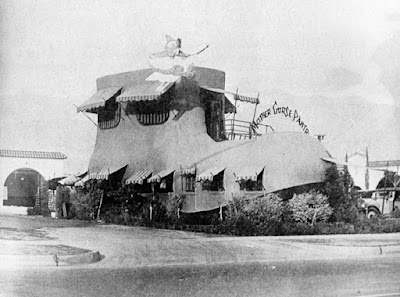"Programmatic architecture" -- or "mimetic" architecture, as it is also called -- is the descriptive name that applies when a building evokes, and/or is designed in the shape of, the product or identity of the business occupying the building -- at least MOST of the time.
Initially, coinciding with the rise of automobile use, programmatic architecture first appeared in the 1920s along roadsides throughout the United States as eye-catching rest and meal stops along the rapidly-growing US Highway system.
The significant proliferation of programmatic architecture in Southern California, and in particular in Los Angeles, also arose in the 1920s and flourished for several decades thereafter, due to a great extent to the increasing love affair with automobiles that had by then become affordable to the masses, SoCal's wide open spaces even in urban areas and its proximity to a variety of natural resources providing affordable leisure activities, the ongoing development of an increasingly-viable connecting highway system, and the moderate climate of the region that provided the perfect year round weather for excursions by car.
To that enticing "mix" was added the influence of the film industry which fostered creativity and opened up opportunities for design specialists and construction workers during the Great Depression that was unrivaled elsewhere in the US, and for the most part, made Southern California immune from the crippling poverty and unemployment that the rest of the country was experiencing throughout the 1930s.
For all these reasons, the Los Angeles area became home to one of the highest concentrations of the programmatic architectural style -- a status it continues to enjoy today because many of the earliest buildings are still extant -- preserved as designated local historical landmarks or repurposed for other uses.
Herein below in this pictorial Blog article, I have chosen a few of these unique, highly-creative, often whimsical 20th Century structures -- some of which have become very famous in their own right not only for their immediately identifiable buildings but also for the businesses associated with them.
 |
| Sphinx Realty Office on Fairfax Avenue in Los Angeles. |
 |
| Fleetwood Square Cadillac Dealership in Tarzana, CA |
 |
| The Binoculars Building designed by Claus Oldenberg in Venice, CA |
 |
| The Coffee Cup Cafe on Pico Blvd. in West Los Angeles |
 |
| Tail 'o the Pup Hot Dog Stand on La Cienega Blvd., in West Hollywood, CA |
 |
| The Freezer Ice Cream Shop in Los Angeles |
 |
| Mother Goose Pantry Restaurant in Pasadena, CA |
 |
| The Flower Pot Flower Shop in Hollywood, CA |
 |
| The original Brown Derby Restaurant on Wilshire Blvd. in Los Angeles |
(Primary Sources: Weird California; Los Angeles Conservancy; Los Angeles Public Library Archives)



No comments:
Post a Comment
Note: Only a member of this blog may post a comment.